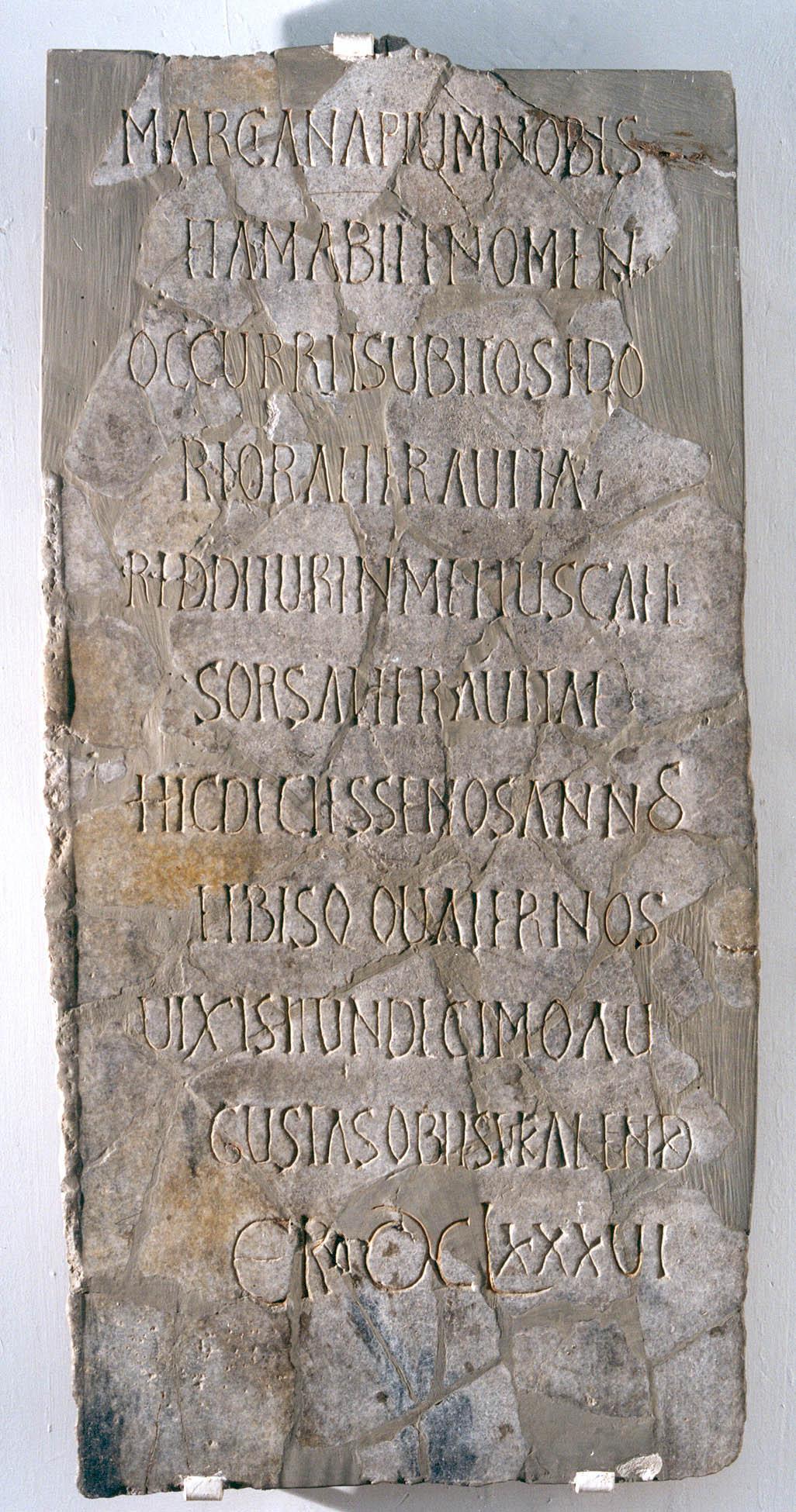Epitaph of Marciana
Reference ICERV 536 | Description | Lyrics | Location | Chronology | Epigraphic edition | Translation | Apparatus | Comentary | Type of verse | Text divided into verses and metric signs | Images | Bibliography | Link to DB | Author |
Epitaph of Marciana
Description
- Idno filename 22/01/0025
- Type of inscription: Sepulcralis Christ.
- Support: Tablet
- Material: Marble Material Description: Black colour.
- Conservation status: Broken into multiple fragments (86 according to COLLANTES DE TERÁN), reconstructed. The upper part of the stone, with at least one line, is missing. Rough sides. In some of the fragments from the left side there are indications that the epigraphical field was framed and even lowered about 2 mm.
- Dimensions height/width/depth (cm): 113.5/56/2.2
-
Epigraphic field:
- Layout: The distance between the last line and the end of the conserved epigraphical field is 14.5. Good layout. Hexameters systematically divided into two lines; in ll. 1, 3 and 5 the verse is cut at the hepthemimer. Second part of the verse indented. Rounded and deeply cut letters. Triangular interpunction at the end of verse 2 and line 4; traces of another one at the end of line 2.
- Epigraphic field dimensions hieght/weight (cm): 113.5/53.5
- Decoration: The only remains are indecipherable, perhaps four letters, or more likely, fragments of some Visigothic decorative motif: chrismon, doves, etc.
- Preserved
Lyrics
- Font:Capital redondeada
- Letter size:4-5 and nexus 5,5 cm
- Description of the letters:Cramped letters in l. 1 (<CI>), 5 (<LI>) and in the number of the date (<LXX>). Ligature in l. 7 (<O^S>) and abbreviation in l. 10 (Kalend), marked with an oblique stroke across the <D>. Very round <U>. Carefully executed <X>.
Location
- Place of discovery: From Castilleja de Talhara (Aznalcázar, Sevilla) (Olontigi; on the name and position of this city, cf. CILA SEVILLA, IV, 21-22). According to previous editors, it was found circa 1940, in a highly fragmented state.
- Geolocation
- Conservation location: Its owner, Excmo. Sr. Marqués de las Torres de la Pressa, gave it to the M.A.P. in Sevilla in 1946, where it is now conserved (inv. no. 2679), in room XXVI.
- Inventory number: 2679
- Location with Modern Nomenclature España / Sevilla / Aznalcázar
- Location with Old Nomenclature Hispania / Baetica / Hispalensis / Olontigi
Chronology
- Inscription's dating: From year 648
- Dating explanation: Date given on the inscription is 22 July 648 AD.
Type of verse
- Type of verse: Dactílico (hexámetro)
- Verse/line correspondence: No
- Prose/verse distinction: No
Epigraphic edition
‑ ‑ ‑ ‑ ‑ ‑
+4+
Marciana pium nobis
et amabile nomen ▴ occụṛṛiṭ subito sed [‑ ‑ ‑]
5 rior ạḷṭẹra vita ▴
ṛẹdditur in melịuṣ caeli
sors altera viṭae
hic decies senos ann⁽os⁾
ẹt bisq(ue) quaternọs
10 vixisti undecimo Au-
gustas obiisti Kalend(as)
era DCLXXXVI
Text divided into verses and metric signs
Marciana, pium nobis et amabile nomen. lw|lww|l/l|l/ww|lww|l~
occurrit subito sed […]rior altera vita, ll|l/ww|l/l|[l]ww|lww|l~
redditur in melius caeli sors altera vitae. lww|l/ww|l/l|l/l|lww|l~
hic decies senos annos et bisque quaternos lww|l/l|l/l|l/l|lww|l~
5 vixisti, undecimo augustas obiisti Kalendas. ll|lww|ll|l/kk|llk|l~
Translation
“Marciana, a name pious to us and worthy of being loved. The next life suddenly comes upon you,...; another type of life, that of heaven, is given to you for the better. Here you lived for sixty-eight years and died on the twenty-second of July. In the era 686”.
Bibliography
Vives, ICERV 536; González Fernández, CILA II, 1031; Fernández-Chicarro – Fernández Gómez 1980, 187–188; Salvador 1998, 143 n. 249; Fernández Martínez – Carande, CLEB, SE3, cum im. phot, quae in linguam Hispanicam verterunt. – Cf. Mariner 1952, 13, 96; ESCOLÀ 2013, 115.
Apparatus
3 occ[urrit] Vives, Salvador; occ..rit Fernández-Chicarro – Fernández; occ[ur]rit González Fernández; orior Collantes de Terán, Fernández-Chicarro – Fernández; [p]rior González Fernández; verior coniecit Mariner. – 7 ann(o)s González Fernández.
Comentary
Hexameters in two lines, and line endings probably marked with interpunction signs in even-numbered lines. L.1 has a trochee in the first foot, in the proper name. In l. 2 we should reconstruct a long syllable as the first element of the fourth foot; the space remaining at the right of the stone leads us to assume about two letters, so we propose verior (as did Mariner), purior or serior. In l. 11 obiisti, shortening of the final post-tonic syllable, quite common in an open syllable from late Latin on.
Mariner (1952, 217-218) assumed that a first verse was missing: inspice, quisquis ades, titulum et cognosce viator, with Marciana as denominative nominative. At the end of l. 4 we could reconstruct serior with an intensive meaning, appropriate for Marciana’s age (sixty-eight); cf. other sequences in which sere / serus appears as predicate: CLE 1128,5; 1805,2; Ov. Her. 11,21-2; 19,14. Obscure syntax in ll. 6-7. The age of the deceased successfully fits into the verse (ll.8-9) with multiplicatives and a superfluous -que (cf. in this respect Cugusi 1996, 395, who quotes the first verse of an inscription from the end of the 4th c. published by Buonocore in Suppl. Ital. n.s. II, p. 129 n.: quanta sit claritas tantaque benignitasque; cf. also Fernández Martínez 1998-99).
Author
- Author:C. Fernández Martínez, R. Carande Herrero
- Last Update2024-02-27 10:01:26
- Autopsy date:2001
You can download this





